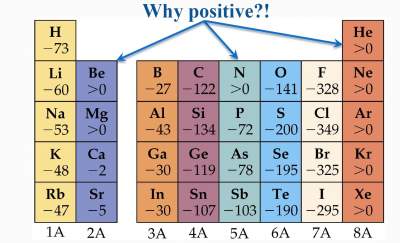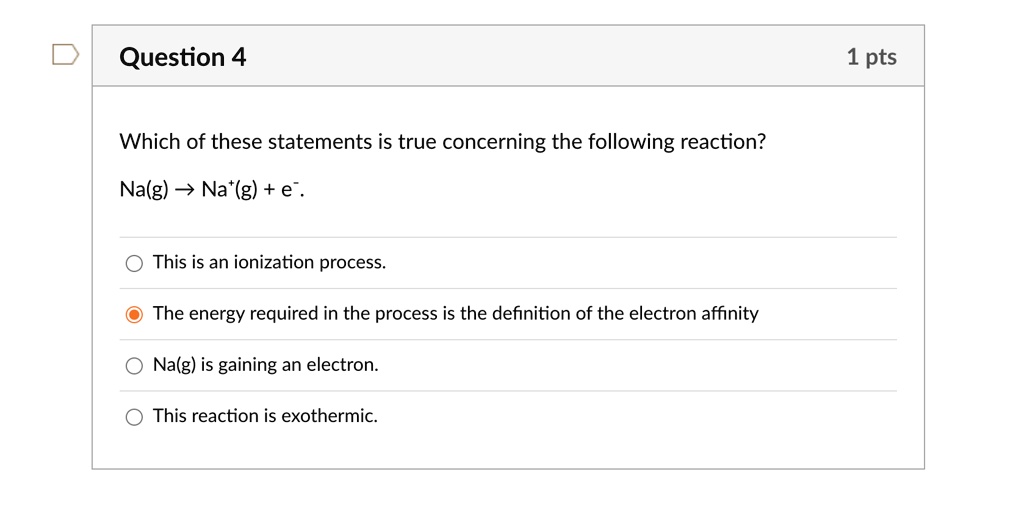

Electron proximity to these respective nuclei also influences this phenomenon, but contrary to the previous trend, electrons are placed in higher energy levels.

Down GroupsĪs we travel down groups, electron affinities become more negative, meaning the process is more endothermic. These electrons exhibit a stronger attraction to the nuclei as a result of this proximity, explaining the exothermic nature of their electron affinities. Scientists attribute this pattern to the addition of electrons closer to the nuclei of these more rightward atoms.Īs elements trend to the right, the added electrons sit closer to their nuclei. Periodic Trends Across PeriodsĪs we travel from left to right on the periodic table, electron affinities become more positive- meaning that the electron attachment process is more exothermic. This results in positive second electron affinity values. This endothermic process requires more energy than is released when an electron is added to the system. The second pertains to the addition of an electron to a negative ion. Because this exothermic process releases energy, first electron affinities are negative values. The first involves the addition of an electron to a neutral atom. There are two types of electron affinity, first and second. Essentially, electron affinity pertains to the energy changes that accompany the gain of one electron, and ionization energy those that accompany losing one electron. Ionization energies always involve the formation of positive ions, electron affinity energies describe the generation of negative ions. It is the opposite of ionization energy, the energy required to ionize a gaseous atom and consequently remove an electron. We tend to liken electron affinity to an atom’s “likelihood,” or “chance,” of gaining an electron. This process differs from electronegativity, which we define as the ability of an atom to attract an electron toward itself. Topics Covered in Other ArticlesĬhemists define electron affinity as the change in energy, measured in units of kJ/mole, experienced when an electron is added to a gaseous atom. However, there are many exceptions, owing in part to inherent difficulties in accurately measuring electron affinities.In this tutorial about electron affinity, we will cover its definition, relevant periodic table trends, and factors that influence it. In general, electron affinities increase (become more negative) from left to right across a period and decrease (become less negative) from top to bottom down a group. Period and group trends for electron affinities are not nearly as regular as for ionization energy. The addition of one more electron gives the halide ions the same electron configuration as a noble gas, which we have seen is particularly stable. The outer configuration of all halogens is ns 2 np 5. Considering electron configuration, it is easy to see why. This means that more energy is released in the formation of a halide ion than for the anions of any other elements. The elements of the halogen group (Group 17) gain electrons most readily, as can be seen from their large negative electron affinities. Electron affinities are negative numbers because energy is released. Electron affinities are measured on atoms in the gaseous state and are very difficult to measure accurately.įigure 1. Electron affinities (in kJ/mol) of the first five periods of the representative elements. The figure below shows electron affinities in kJ/mole for the representative elements. When energy is released in a chemical reaction or process, that energy is expressed as a negative number. The energy change that occurs when a neutral atom gains an electron is called its electron affinity. This can be shown for the chloride ion formation below: In most cases, the formation of an anion by the addition of an electron to a neutral atom releases energy.

Addition of an electron releases energy from the process. When electrons are removed from an atom, that process requires energy to pull the electron away from the nucleus. When electrons are added to an atom, the increased negative charge puts stress on the electrons already there, causing energy to be released. When the suitcase is over-full, there is stress on the system and forces pushing the suitcase open. What do you take with you? Where will you be going and what will you need? We usually pack too much (like the suitcase above) and then find it hard to close the suitcase. Packing for a trip can be very challenging. Do you tend to overpack before going on trips?


 0 kommentar(er)
0 kommentar(er)
